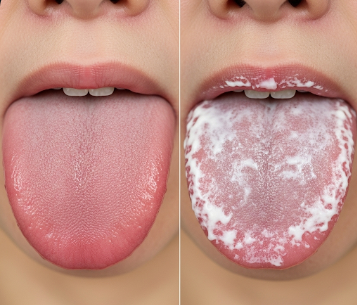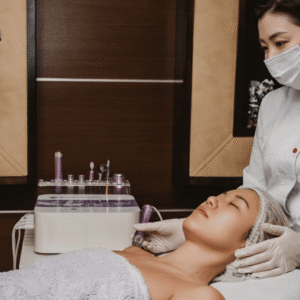➤ Overview
A sore or white tongue refers to discomfort, pain, or abnormal coloration of the tongue, often accompanied by a white coating or patches. This condition can arise from oral infections, inflammation, nutritional deficiencies, or systemic health issues.
In South Korea, evaluation is performed by dentists, ENT specialists, and general physicians. Diagnostic tests may include oral swabs, blood tests, and imaging, ensuring precise identification of the cause. Early intervention is critical to prevent complications, relieve pain, and improve oral and overall health.
➤ Key Facts
→ A sore or white tongue may result from infection, irritation, or systemic disease.
→ Common causes include oral thrush, leukoplakia, geographic tongue, trauma, or vitamin deficiencies.
→ In Korea, oral examination and laboratory tests are standard for accurate diagnosis.
→ Chronic or persistent white tongue may indicate serious conditions like precancerous lesions.
→ Symptom relief may involve topical treatments, oral hygiene improvement, and addressing underlying causes.
→ Can affect eating, speaking, and overall quality of life.
→ Early treatment prevents secondary infections and long-term complications.
➤ What is Sore or White Tongue?
A sore or white tongue represents changes in the tongue’s surface, color, or texture:
→ Soreness – Pain, burning, or irritation of the tongue.
→ White coating – Thick or patchy layer on the tongue surface.
→ Red or inflamed areas – Sometimes accompany white patches.
→ Texture changes – Smooth, rough, or geographic patterns.
→ Underlying health indicator – Can signal oral infections, systemic illness, or nutritional deficiencies.
→ Functional impact – May cause difficulty swallowing, speaking, or tasting food.
➤ What Symptoms are Related to Sore or White Tongue?
Symptoms vary depending on the underlying cause:
→ Pain or burning sensation → Especially with spicy or acidic foods.
→ Bad breath (halitosis) → Often accompanies oral infections or poor hygiene.
→ Swelling or redness → Indicative of inflammation.
→ White or yellow patches → May be indicative of fungal infections like oral thrush.
→ Loss of taste or altered taste → Changes in taste perception.
→ Cracks or fissures → Seen in conditions like fissured tongue or dehydration.
→ Dry mouth → Can exacerbate soreness and coating.
→ Fever or systemic symptoms → In infections or systemic illnesses.
➤ What Causes / Possible Causes?
Sore or white tongue can arise from infectious, inflammatory, nutritional, or systemic causes:
→ Oral candidiasis (thrush) – Fungal infection causing white, creamy patches.
→ Leukoplakia – Precancerous white patches, often linked to smoking or irritation.
→ Geographic tongue – Benign condition with irregular red and white patches.
→ Vitamin deficiencies – Deficiency in B vitamins, iron, or folate.
→ Trauma or irritation – Biting, rough teeth, or ill-fitting dental appliances.
→ Poor oral hygiene – Accumulation of bacteria and debris causing white coating.
→ Dry mouth (xerostomia) – Reduces natural cleansing, leading to coating.
→ Systemic conditions – Diabetes, immunodeficiency, or autoimmune diseases.
→ Medications – Antibiotics, corticosteroids, or chemotherapy can trigger oral changes.
➤ When Should I See My Doctor?
Medical evaluation is recommended if the tongue appears:
→ Persistently white or sore for more than two weeks.
→ Painful, bleeding, or ulcerated – Could indicate infection or precancerous lesions.
→ Associated with swelling, fever, or systemic symptoms – Possible infection or systemic disease.
→ Recurring or chronic – Suggests underlying health issue.
→ Difficulty swallowing or speaking – Impairs daily life.
→ In Korea, dentists and ENT specialists use oral swabs, blood tests, and imaging for proper diagnosis.
➤ Care and Treatment
Treatment depends on cause and severity:
→ Antifungal therapy – Topical or systemic treatment for oral thrush.
→ Improved oral hygiene – Brushing, flossing, and tongue cleaning.
→ Nutritional supplementation – Vitamins and minerals for deficiencies.
→ Pain relief – Topical anesthetics or mouth rinses.
→ Avoid irritants – Spicy foods, alcohol, or tobacco.
→ Hydration – To alleviate dryness and promote healing.
→ Monitoring – For recurrent white patches or chronic soreness.
→ Referral to specialists – For leukoplakia, systemic disease, or chronic oral conditions.
➤ Treatment Options in Korea
South Korea provides advanced oral and systemic care for sore or white tongue:
Diagnosis in Korea
→ Oral examination – Visual assessment of tongue, oral cavity, and surrounding tissues.
→ Swab cultures – Identify fungal or bacterial infections.
→ Blood tests – Check for nutritional deficiencies, diabetes, or immune status.
→ Imaging – Rarely used, but may assess deep tissue involvement.
→ Multidisciplinary evaluation – Dentists, ENT specialists, and physicians collaborate for accurate diagnosis.
Medical Treatments in Korea
→ Antifungal and antibacterial medications – For infections causing white coating or soreness.
→ Pain relief and anti-inflammatory therapy – Mouth rinses, gels, or systemic medications.
→ Nutritional support – Supplements for B vitamins, iron, or folate deficiencies.
→ Lifestyle modifications – Smoking cessation, oral hygiene, and avoiding irritants.
Advanced Therapies in Korea
→ Laser or surgical therapy – For persistent leukoplakia or precancerous lesions.
→ Specialist monitoring – For systemic conditions like diabetes, immunodeficiency, or autoimmune disease.
→ Patient education – Proper oral care, hydration, and dietary advice to prevent recurrence.
Rehabilitation & Support in Korea
→ Follow-up monitoring to ensure resolution of lesions or infections.
→ Guidance on oral hygiene, nutrition, and lifestyle to prevent chronic oral conditions.
→ Support for patients with immune-related or systemic diseases affecting oral health.













